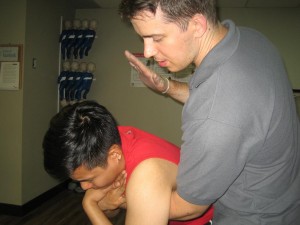Overview Of Choking
- A person chokes when the airway is partially or entirely blocked and airflow to the lungs is restricted or cut off. The choking victim either has difficulty breathing or cannot take in air at all. A choking casualty might pass on if first aid is not given straight away.
- Breathing is a vital part of our existence. When we breathe in, we inhale in a blend of oxygen, nitrogen and carbon dioxide
- Our bodies utilize oxygen as a source to create energy from the food we consume.
- When a casualty is choking with a fully obstructed airway, no air can go into the lungs. The brain is exceptionally responsive to this lack of oxygen and begins to die within 4 to 6 minutes. It is at this moment that first aid must occur. Permanent brain death takes place in as little as 10 minutes.
Level Of Air Exchange
- A casualty’s airway can be either partially or entirely blocked. With a partly blocked airway, there is either good air exchange or poor air exchange.
- With good air exchange, the casualty can still cough, breath and talk.
- With poor air exchange, the obstacle is stuck and the casualty can’t cough forcefully, has difficulty breathing or can’t talk.
- With a totally blocked airway, there is no air exchange – coughing, breathing or talking is not possible.

Signs Of Choking
The most obvious sign of choking is clutching of the throat. As a first aider, you need to know how to recognize whether a choking person has a mild or severe obstruction because the first aid is different for each.
Mild Obstruction:
- Able to talk;
- Signs of anguish – eyes demonstrate panic;
- Able to still cough;
- Breathless between coughs;
- Red face; and
- Grasping of the throat.
Severe Obstruction:
- Not able to talk;
- Signs of anguish – eyes demonstrate fear;
- Fragile or no coughing;
- High-pitch voice or no voice when breathing;
- Bluish lips; and
- Grasping of the throat.
Choking Situations
There are two choking situations you may have to deal with:
- A conscious choking casualty who may become unconscious while you are giving first aid.
- An unconscious person, who, you discover through your first aid actions, has a blocked airway.
The first aid you give depends on the casualty’s age. In first aid for choking, an adult is post-puberty, a child is between one year and puberty, and an infant is under one year. The casualty’s size must also be considered. There are variations in the techniques for a casualty who is pregnant or larger than the first aider or in a wheelchair.
Related Video on Choking
https://www.youtube.com/watch?v=Wuo893OC0yE
